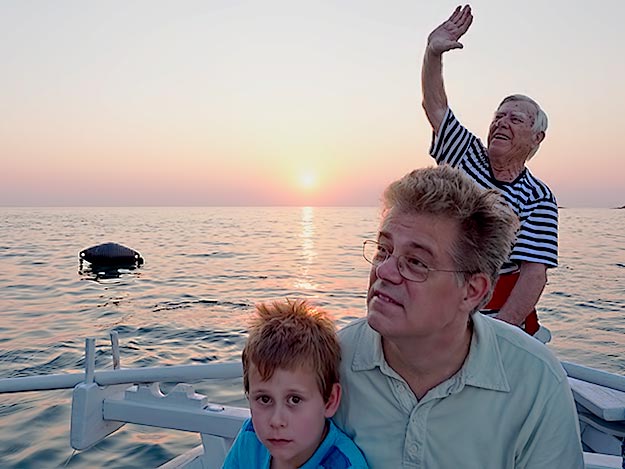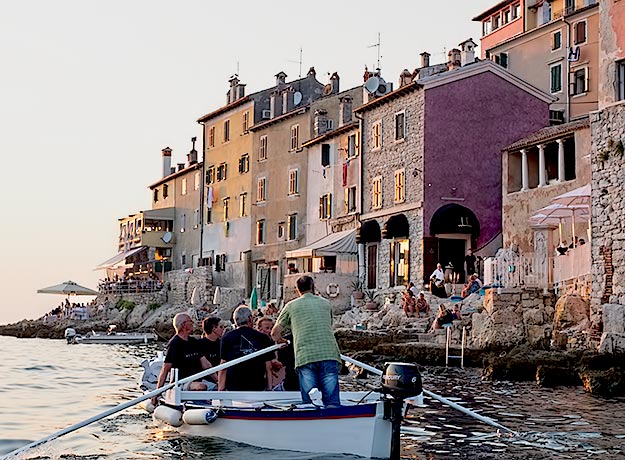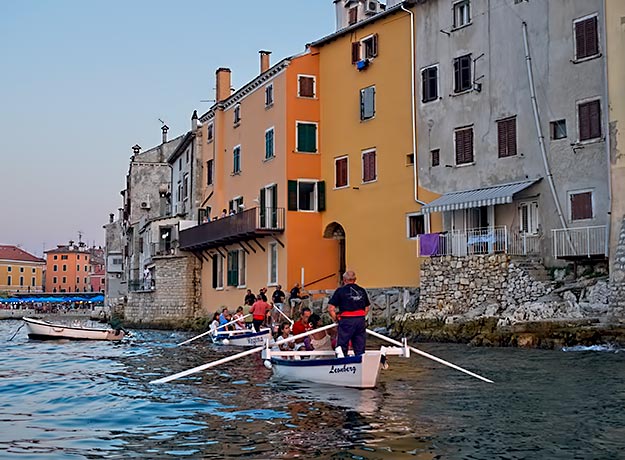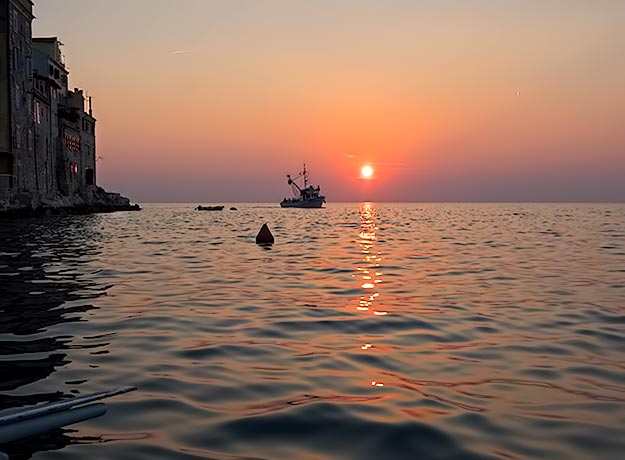The captain wielded his long white oars like hot knives through butter, each dip barely dimpling the glassy sea. His muscled arms moved fluidly, tiny adjustments keeping us on our course around the old city of Rovinj. We rounded the ancient pier and hugged the coast, where sun-splashed houses of many colors balanced precariously on rock outcroppings. Every so often, he abandoned the oars to smile and wave at a passing boat or residents who hung out of their windows, watching our little parade. “Ciao! Come va?” He seemed to know everyone.

Banich Zerro Giordano is one of a vanishing breed of fishermen who have for centuries plied this part of the Adriatic in flat-bottom wooden boats known as batanas. Like the 27 other owners of the remaining batanas of Rovinj, he rows out to sea each day, employing a unique collection of nets and hooks to catch fish. But on this day, rather that sinking lines or pulling up nets, our five tiny boats (one carrying musicians who serenaded us with traditional folk ballads known as Bitinadas), were bound for a seafood feast at a local taverna.

The history of Rovinj has always been intertwined with the sea. Although there is archaeological evidence of human habitation on the site as far back as the Bronze Age, the city emerged in the third century, when fishermen settled on this miniature island along the Istrian coast of Croatia. With limited land available, they built closely spaced houses topped by tall, narrow brick chimneys; tiny squares; and narrow streets, which they paved with brilliant white marble cobblestones.

In the beginning of the 18th century, when Rovinj began to expand outside the old city walls, the channel between the island and the Croatian mainland was filled in, turning it into a peninsula that thrusts into the Adriatic like a giant swollen thumb. Today, development sprawls beyond the peninsula, but the houses in the old town remain untouched by modern urbanism, and the batanas ply the waters as they have for centuries.

Our batanas pulled up to the taverna’s sea entrance but I opted not to attend the dinner. Instead, I returned to the pier with Captain Giordano, wanting my time in the tiny boat to last forever. As the setting sun turned the sky to stripes of orange and violet sherbet, we retraced our path past houses that reflected on the mirrored surface of the harbor like dazzling jewels.

Back at the pier, I clambered out of the boat, noting Captain Giordano’s suggestion that I stop by the canopied area where one of the town’s fishermen is building a traditional batana, using only traditional tools. Five of these vessels have been built over the past five summers, becoming part of the dwindling fleet. When the caulk is seasoned and the final coat of paint has dried, this batana will also be launched by Rovinj fishermen, who understand that “a batana lives only when it is in the sea and serves it’s master.” I hope it is not the last one they build. I hope they find a way to preserve their simple way of life forever.
Traveler’s Information: Batana boat rides are organized by the Batana Eco-museum, located at the head of the head of the Great Pier. They are conducted every Tuesday and Thursday from June 25th through September 5th, between 7:30 and 11 p.m. The boat ride alone costs 60 Croatian Kuna, while the combination boat ride and dinner at Spacious Matika Taverna is priced at 180 Kuna. The exchange rate at the time of writing was slightly less than 7 Kuna for every U.S. dollar. Reservations are recommended.

I am so excited to have found your blog! You are an amazing writer and living a great truth in your life! My wife and I loved Chiang Mai and I would have loved to live there as well, however she likes Canada as our home base, but she is young still…… I love that you are living your life so great at your age, I am 46 and looking forward to travel more now than ever
I can not believe I found this amazing experience and can not wait to go. We will be going to Zurich, Benina Express to Italy (Florence, Rome and Naples), then heading to Croatia and renting a car, staying 4 days in Rovinj and then Munich.
Do you have any thoughts on must see places within these places?
Hi Kath: Thanks so much for your kind comments. I’m so pleased you’ve found my blog to be helpful. I’ve visited most of the places you plan to go, and of course, I’ve written about them as well. I think the best idea would be for you to read those articles, as tips would be too long for a comment. Just go to my menu bar at the top and choose destinations. Then, from the drop-down menu, you can choose the country and see all the articles I’ve written about it. Happy travels!
Firstly, the sunset photos are stunning, depicting beauty, peace and tranquility. I’ve always wanted to visit Croatia and the Adriatic. Its history is steeped rich in culture, wonderful seaside cuisine and intriguing stories of locals. I love the quote, “a batana lives only when it is in the sea and serves it’s master,” as it depicts their lifestyle perfectly. Great post and cheers from Korea.
Thank you so much Gary! Your praise means a lot to me.
There is something magical about going on a boat on the sea! Great photos and I’m sure you had a great time!
It was kind of magical, Adrian. Thanks for your comment.